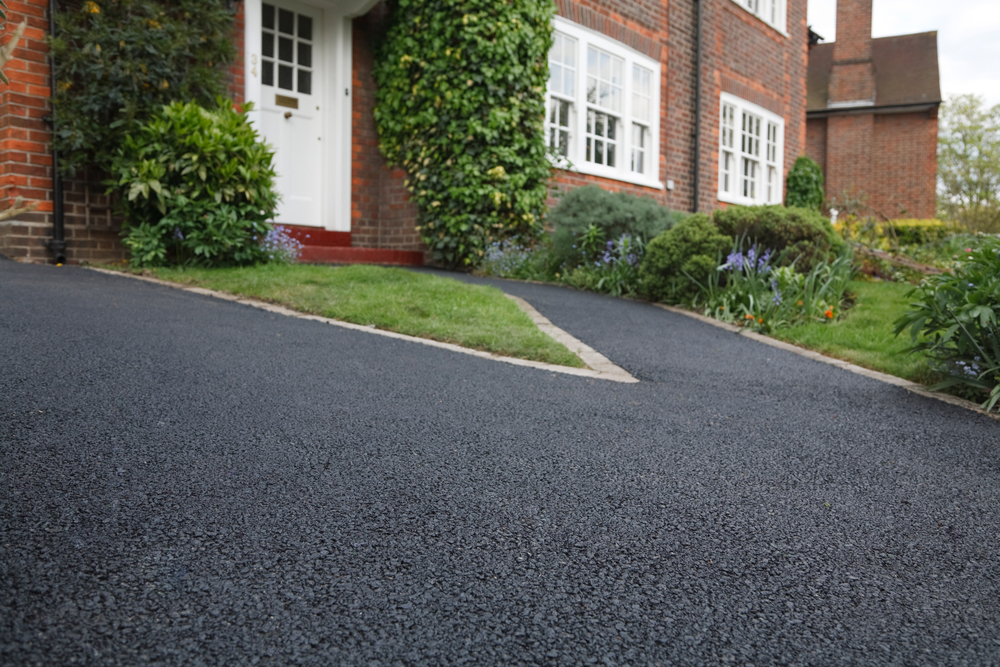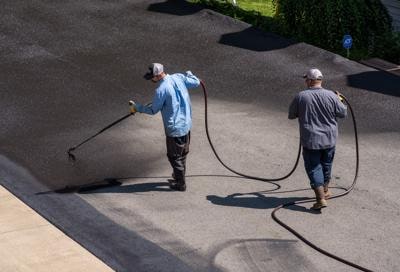Enhance Toughness: Warm Mix Asphalt Sealing for Angled Parking Frameworks
Enhance Toughness: Warm Mix Asphalt Sealing for Angled Parking Frameworks
Blog Article
Warm Mix Asphalt: A Lasting Remedy for Sidewalk
Warm Mix Asphalt (HMA) has actually emerged as a leading lasting choice for sidewalk options, providing a myriad of innovative modern technologies and environmental advantages. As the demand for eco-friendly building and construction techniques grows, discovering the nuances of HMA's sustainability can give valuable insights right into the future of pavement solutions.
Ecological Advantages of Hot Mix Asphalt

Furthermore, Warm Mix Asphalt helps to minimize metropolitan heat island results. Its dark shade absorbs sunshine, decreasing the quantity of heat showed back right into the environment contrasted to lighter-colored pavements. This can reduce ambient temperature levels in metropolitan locations, reducing the need for cooling and eventually lowering energy usage.
In enhancement, Warm Mix Asphalt adds to improved stormwater management. Its porous nature enables water to penetrate the sidewalk and recharge groundwater products, minimizing runoff and the threat of flooding. These environmental advantages make Warm Mix Asphalt a lasting choice for paving roads and highways.
Energy Efficiency in HMA Production
Is energy efficiency an essential consider the production of Warm Mix Asphalt (HMA)? Definitely. Energy plays a considerable function in the production of HMA, affecting both expense and environmental sustainability. One key aspect of energy performance in HMA manufacturing is making use of cozy mix asphalt (WMA) innovations (commercial parking lot paving). WMA permits the blending and placement of asphalt at lower temperatures contrasted to typical warm mix asphalt, leading to decreased energy intake throughout production. This process not just lowers gas usage but also lowers greenhouse gas emissions, making it a more eco-friendly choice.
Furthermore, innovations in plant innovations have brought about more energy-efficient HMA production procedures. Modern plants are designed with attributes like recycled asphalt sidewalk (RAP) processing capacities, reliable burner systems, and improved insulation, all adding to energy financial savings. By enhancing power usage in HMA manufacturing, the market can reduce its carbon footprint while keeping top notch pavement products. Power efficiency is, consequently, a vital factor to consider in making sure the sustainability of Warm Mix Asphalt production.
Recyclability of Hot Mix Asphalt
The recyclability of Hot Mix Asphalt (HMA) is an essential facet of its sustainability and long-term environmental influence. HMA is just one of the most recycled materials in the United States, with over 100 million heaps of redeemed asphalt pavement (RAP) being reused yearly in brand-new sidewalk building and construction. Recycling HMA provides a number of ecological advantages, such as lowering the demand for virgin materials, lowering energy usage during production, and reducing the quantity of waste sent out to land fills.
The process of recycling HMA involves grating the existing pavement, crushing it into smaller pieces, and mixing it with new aggregate and asphalt binder to produce a recycled mix. This recycled mix can commonly do along with and even far better than conventional HMA, while requiring fewer basic materials and producing reduced greenhouse gas emissions. By incorporating RAP into new sidewalk tasks, roadway firms can save all-natural resources, lower prices, and decrease the ecological footprint of road construction and maintenance tasks. On the whole, the recyclability of HMA plays a substantial duty in promoting sustainable practices within the sidewalk market.

Long-Term Efficiency of HMA
Asphalt sidewalks show durability and resilience over a prolonged period, showing the long-lasting efficiency of Warm Mix Asphalt (HMA) The longevity of HMA can be attributed to its capability to stand up to rush hour loads, severe climate condition, and the effects of aging. Research studies have revealed that well-designed and properly constructed HMA sidewalks can last for two decades or even more with routine maintenance. The key to taking full advantage of the long-lasting performance of HMA depends on making use of high-grade materials, following best techniques in construction, and applying effective maintenance methods. Appropriate water drainage, regular assessments, and timely repair work are important for protecting the structural integrity of HMA sidewalks gradually. Furthermore, advancements in HMA modern technology, such as using polymer-modified binders and warm mix asphalt, have actually additionally enhanced the durability and long life of HMA pavements. By focusing on high quality construction and upkeep practices, HMA proceeds to prove itself as a cost-efficient and sustainable remedy for lasting sidewalk infrastructure.
HMA: Longevity and Sustainability
Showing both toughness and sustainability, Warm Mix Asphalt (HMA) has come to be a foundation in the construction of durable sidewalk infrastructures - commercial parking lot paving. HMA's toughness comes from its capability to withstand hefty loads, extreme climate condition, and high website traffic quantities, making it a reputable choice for roadways, highways, and airport terminal runways. The structure of HMA, which commonly includes aggregates, binder, and filler, plays an essential role in enhancing its long life and resistance to tear and wear
Furthermore, HMA's sustainability hinges on its recyclability and energy-efficient manufacturing process. The capability to recycle reclaimed asphalt pavement (RAP) in new HMA combinations reduces the demand for virgin products and decreases the ecological impact of pavement building and upkeep. In addition, my website the energy efficiency of creating HMA depends on its reduced blending temperature levels compared to other pavement materials, resulting in minimized power intake and greenhouse gas exhausts.
Verdict
In verdict, warm mix asphalt (HMA) offers a click this link sustainable service for pavement with its eco-friendly qualities. HMA's recyclability, energy effectiveness in production, and long-lasting longevity make it an environmentally friendly option for roadway construction. By preserving natural resources, reducing waste, and lowering greenhouse gas emissions, HMA plays a vital duty in advertising sustainability in framework growth. Its capacity to minimize urban heat island effects additionally emphasizes its value in developing eco mindful and durable pavement systems.
HMA is one of the most recycled materials in the United States, with over 100 million tons of redeemed asphalt sidewalk (RAP) being reused annually in brand-new pavement building.The process of recycling HMA involves crushing the existing sidewalk, crushing it right into smaller pieces, and mixing it with new accumulation and asphalt binder to create a recycled mix.Asphalt sidewalks demonstrate resilience and resilience over a prolonged duration, showing the lasting performance of Warm Mix Asphalt (HMA) Additionally, innovations i loved this in HMA innovation, such as the usage of polymer-modified binders and warm mix asphalt, have actually further improved the durability and durability of HMA sidewalks. The capability to recycle recovered asphalt pavement (RAP) in new HMA combinations decreases the need for virgin products and reduces the ecological effect of sidewalk building and construction and maintenance.
Report this page